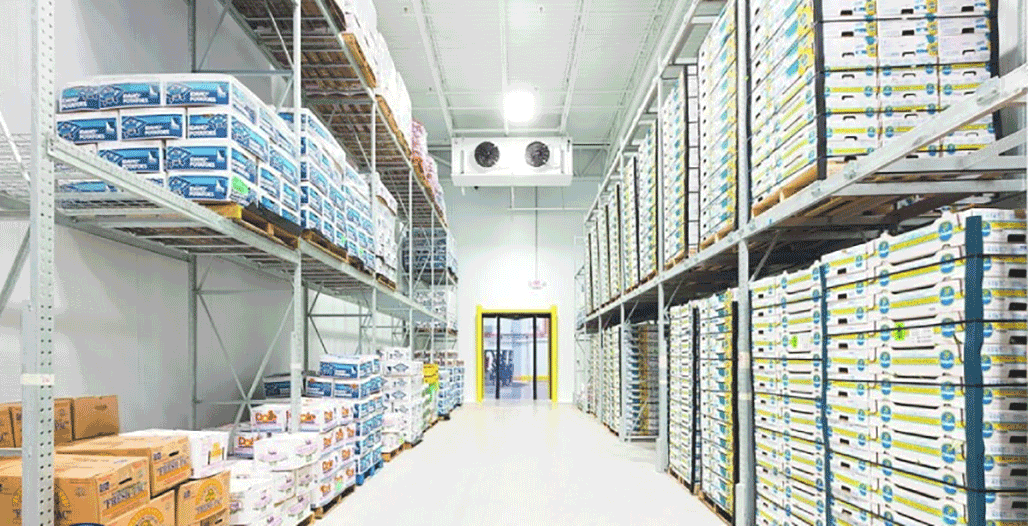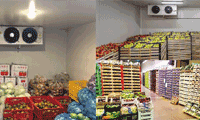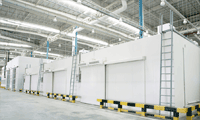✅ 1. Nhiệt độ bảo quản rau củ quả
- Nhiệt độ lý tưởng:
- Rau ăn lá: 0°C – 5°C
- Trái cây (chuối, xoài, bơ): 12°C – 15°C
- Rau củ quả thông dụng (cà rốt, khoai tây, cà chua): 3°C – 8°C
- Độ ẩm: 85% – 95% (để tránh mất nước, héo úa).
✅ 2. Đặc điểm kho lạnh bảo quản rau củ quả
- Không dùng nhiệt độ quá thấp (tránh đóng băng làm hư hỏng cấu trúc mô thực vật).
- Thiết kế thông gió tốt để phân bố nhiệt độ đều và tránh ngưng tụ hơi nước.
- Hệ thống tạo ẩm (nếu cần) để duy trì độ ẩm cao.
- Panel cách nhiệt dày 75–100 mm là đủ (không cần quá dày như kho đông lạnh).
- Dàn lạnh thổi gió nhẹ để không làm rau bị khô.
✅ 3. Cấu tạo cơ bản
- Tường & trần: Panel PU cách nhiệt 75–100 mm.
- Sàn kho lạnh: Có lớp cách nhiệt chống thất thoát nhiệt, chống trơn.
- Cửa kho: Cửa cách nhiệt có gioăng kín.
- Máy nén & dàn lạnh: Công suất tùy theo diện tích, có bộ điều khiển tự động.
- Hệ thống điều khiển: Giữ ổn định nhiệt độ từ 0°C đến 15°C.
✅ 4. Ưu điểm kho lạnh rau củ quả
✔ Kéo dài thời gian bảo quản từ vài ngày lên 1–2 tháng
✔ Giữ được màu sắc, độ tươi và giá trị dinh dưỡng
✔ Giảm hao hụt và hư hỏng trong quá trình lưu kho
✅ 5. Dung tích & quy mô
- Kho nhỏ: 10 – 20 m³ (dành cho cửa hàng, siêu thị mini).
- Kho trung bình: 50 – 100 m³ (nông sản sau thu hoạch).
- Kho lớn: Hàng trăm m³ (xuất khẩu, trung tâm phân phối).
✅ 1. Duy trì nhiệt độ tối ưu
- Giữ ổn định từ 0°C đến 15°C tùy loại rau quả.
- Hệ thống điều khiển tự động, sai số nhiệt độ rất nhỏ.
- Có chế độ cảnh báo khi nhiệt độ vượt ngưỡng.
✅ 2. Kiểm soát độ ẩm
- Đảm bảo độ ẩm 85% – 95% để rau không bị héo hoặc khô.
- Một số kho có hệ thống tạo ẩm và cảm biến tự động.
✅ 3. Phân phối khí lạnh đồng đều
- Dàn lạnh thổi gió nhẹ, không làm rau bị khô hoặc đóng băng.
- Thiết kế luồng khí lạnh hợp lý tránh chênh lệch nhiệt độ giữa các vị trí.
✅ 4. Tiết kiệm năng lượng
- Panel cách nhiệt chất lượng cao (PU, EPS).
- Máy nén sử dụng công nghệ Inverter (nếu có) giúp giảm điện năng.
✅ 5. An toàn thực phẩm & bảo vệ sản phẩm
- Không để xảy ra hiện tượng đóng băng rau (làm hỏng cấu trúc tế bào).
- Tránh mất nước, đổi màu, thối hỏng.
- Có thể tích hợp lọc khí, khử khuẩn UV, ozone để hạn chế nấm mốc và vi khuẩn.
✅ 6. Điều khiển & Giám sát thông minh
- Điều chỉnh nhiệt độ qua bảng điều khiển hoặc ứng dụng từ xa.
- Cảnh báo nhiệt độ, mất điện, sự cố qua SMS hoặc app.
✅ 7. Linh hoạt dung tích & thiết kế
- Có thể thiết kế kho lạnh cố định hoặc container lạnh di động.
- Tùy theo sản lượng: từ vài m³ đến hàng nghìn m³.






